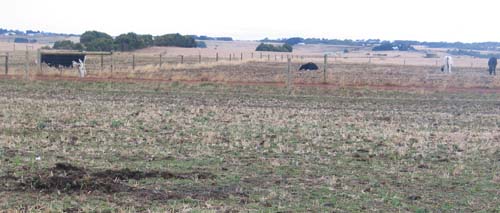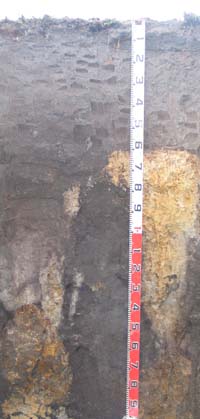CSLP7
Location: Cooriemungle
Australian Soil Classification: Melacic, Pipey, Semiaquic, PODOSOL
General Landscape Description: Dissected Plateau.
Site Description: Very gently undulating plain.
Native Vegetation: Pasture, cattle.
Geology: Neogene sediments (Hanson Plain Sand) over Palaeogene sediments.

CSLP7 Landscape
Soil Profile Morphology:
Surface Soil
| Ap | 0-5 cm | Root mat; |  CSLP7 profile. |
| A11 | 5-15 cm | Very dark brown (10YR2/2); light sandy clay loam; weak fine sub-angular blocky structure; rough fabric; weak consistence dry; pH 4.4; clear change to: | |
| A12 | 15-40 cm | Black (2.5Y2.5/1); sandy clay loam; massive; earthy fabric; firm consistence dry; pH 4.4; diffuse change to: | |
| A13 | 40-60 cm | Very dark grey (10YR3/1); fine sandy clay loam; massive; earthy fabric; weak consistence dry; pH 4.6; sharp change to: | |
| Subsoil | |||
| B21s | 60-150 cm | White (10YR8/2) with faint strong brown (7.5YR5/8) and brown (10YR4/3) mottles common; clayey coarse sand; massive; earthy fabric; very strong consistence moist; contains very many coarse (6-20 mm in size) iron nodules; discontinuous ferruginous pan present; large organic infills; pH 5.7; gradual change to: | |
| B22 | 150-170 cm | Black (2.5Y2.5/1) with common amount of coarse light olive brown (2.5Y5/3) and brown (10YR4/3) mottles; fine sandy clay loam; weak coarse prismatic and polyhedral structure; rough fabric; weak consistence moist; contains common medium (2-6 mm in size) iron segregations; large organic infills; pH 4.7; clear change to: | |
| B23s | 170-195 cm | Dark greyish brown (10YR4/2), with distinct very pale brown (10YR7/3) and dark yellowish brown (10YR4/4) mottles common; coarse sandy loam; weak coarse sub angular blocky structure; rough fabric; strong consistence moderately moist; contains a few fine gravelly quartz, and a common amount of coarse (6-20 mm in size) ferruginous nodules; discontinuous ferruginous pan present; large organic infills; pH 4.7; clear change to: | |
| 2B21/D | 195-200+ cm | Light grey (10YR6/2), with prominent yellowish brown (10YR5/8) and very dark grey (2.5Y3/1) mottles common; light clay to light medium clay (very fine sandy); weak medium angular blocky, parting to moderate fine polyhedral structure; smooth fabric; weak consistence moist; pH 4.7. | |
Soil Profile Characteristics:
pH | Salinity Rating | |||
Surface (A11 horizon) | Extremely Acid | Very Low | Non-Sodic | None |
Subsoil (B21 horizon 60-150 cm) | Moderately Acid | Very Low | Non-Sodic | None |
Very Deep Subsoil (195-200 cm) | Very Strongly Acid | Very Low | Non-Sodic | None |

| The salinity rating is very low throughout the profile. | Clay content is very low in the surface. The clay content increases in the very deep subsoil. |
|
Horizon | Horizon Depth (cm) | pH (water) | pH (CaCl2) | EC (dS/m) | Exchangeable Cations | |||
Ca | Mg | K | Na | |||||
meq/100g | ||||||||
Ap | 0-5 | 5.1 | 4.3 | 0.39 | - | - | - | - |
A11 | 5-15 | 4.4 | 3.5 | 0.06 | 2.1 | 0.49 | 0.17 | 0.16 |
A12 | 15-40 | 4.4 | 3.7 | <0.05 | 0.36 | 0.09 | <0.05 | 0.09 |
A13 | 40-60 | 4.6 | 4 | <0.05 | 0.13 | <0.05 | <0.05 | 0.07 |
B21s | 60-150 | 5.7 | 5.2 | 0.08 | 0.95 | 0.11 | <0.05 | 0.08 |
B22 | 150-170 | 4.7 | 4.2 | <0.05 | 0.06 | 0.10 | <0.05 | 0.14 |
B23s | 170-195 | 4.7 | 4.4 | 0.05 | 0.10 | 0.09 | 0.07 | 0.17 |
2B21/D | 195-200 | 4.7 | 4.1 | 0.06 | 0.13 | 0.28 | 0.13 | 0.27 |
Horizon | Horizon Depth (cm) | Exchangeable Acidity meq/100g | Total Nitrogen % | Organic Carbon g/100g | Exchangeable Aluminium mg/kg | Field Capacity pF2.5 | Wilting Point pF4.2 | Coarse Sand (0.2-2.0 mm) | Fine Sand (0.02-0.2 mm) | Silt (0.002-0.02 mm) | Clay (<0.002 mm) |
Ap | 0-5 | - | 1.3 | 21 | <10 | 59.6 | 42.1 | 40 | 26 | 3 | 2 |
A11 | 5-15 | 20 | 0.31 | 7.7 | 110 | 29 | 13.3 | 36 | 35 | 8 | 5 |
A12 | 15-40 | 15 | 0.096 | 3.5 | 230 | 12.1 | 5.3 | 34 | 42 | 9 | 8 |
A13 | 40-60 | - | 2.4 | 190 | 21 | 5.3 | 36 | 42 | 9 | 9 | |
B21s | 60-150 | 8.9 | - | 33 | 23 | 7.2 | 31 | 40 | 11 | 15 | |
B22 | 150-170 | - | 2.1 | 190 | 22.1 | 10.1 | 29 | 35 | 14 | 16 | |
B23s | 170-195 | - | 210 | 36 | 17.8 | - | - | - | - | ||
2B21/D | 195-200 | 15 | 310 | 37.8 | 22.7 | 18 | 18 | 22 | 42 |
Profile Described By: David Rees, Nathan Robinson (March 2009).


